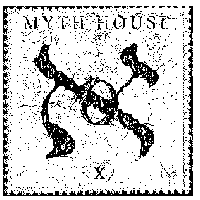anchoring images
Ted Nelson (as with so many things) invented web banners -- the advertising links that, for now, form the economic foundation of the Web. He did this back in 1987, in a keynote talk at the First Hypertext Conference, in a slide depicting the hypertext page of the future. Instead of subtle, easy-to-read, aesthetically pleasing cues, Nelson's page was filled with links that clamored for attention:
- Try Me!
- I'm good!
- I'm better!
As we all have so often done, many of us thought Nelson was kidding. We were, of course, wrong.
What most hypertext writers -- and almost all Web advertisers -- miss, though, is that link anchors don't need to represent themselves so simply. The image (or text) that tells the user "a link is here" often describes the destination, but this isn't always the only choice, or the best choice.

Tim McLaughlin's new hypertext novel, Notes Toward Absolute Zero, uses postage stamps as navigational anchors: the frontispiece is a stamp collection, and each stamp leads to a distinct section. Some stamps seem real, others are surreal, but the stamps both introduce and comment upon the contours they introduce. A stamp shows a standing railroad locomotive, motionless antique iron on display, but the commentary that follows is far from motionless:
Many of the most surreal stamps are found not on the frontispiece but on its shadow node, the "backispiece". A similar shadow-world also occurs in John McDaid's seminal Uncle Buddy's Phantom Funhouse, where the closet of the late Arthur Newkirk's home contains an house filled with strange echoes of the entire hypertext.
This is a story that takes space and movement. It begins when you realize you can never control more than half the act of travel. Claim the departure as your own if must, but leave your arrival to others. If you find yourself elsewhere, perhaps alone cold and sleepless in a hotel room, it is because you have lost control of something.
Travel is an argument between places.
If travel is an argument between places, this epigram is an argument with the image that introduces it. The combination, thesis and antithesis, provokes thought and involvement in a way that a simpler representation (a speeding train) would not.
A link anchor needs to be noticed, but it also needs to attract the people who really ought to follow that link and to prepare them for what the link will deliver. Anchors can create drama, build surprise, or comment ironically on their destinations, not just attract the eye or encourage casual surfers.
